A Genealogy Speaker’s Life
Join me for a peek inside this speaker’s life. Last week I was in Provo, Utah for the BYU Conference on Family History & Genealogy, with production assistant (and awesome daughter!) Hannah by my side. It was a full week of teaching (6 sessions),...Busting Genealogical Brick Walls with a Podcast
Podcasts are hotter than ever. Folks listen while doing a wide range of activities: working, exercising, commuting, cooking or simply relaxing.
My hope is that as you listen to the free Genealogy Gems Podcast (and the ad-free Genealogy Gems Premium Podcast to which our members have exclusive access) you’ll not only listen, but put into action the ideas and strategies that you hear.
That’s why it’s so rewarding when a listener takes the time to write and let me know what they accomplished using the techniques they heard about on the show or in our videos.
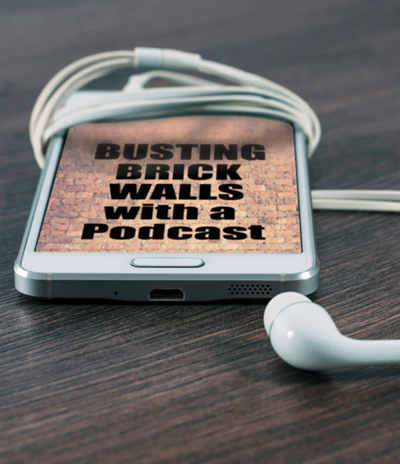
Busting Genealogy Brick Walls
But can a podcast help you bust a genealogical brick wall? Well, according to listener and Genealogy Gems Premium member Natalie Zett, you bet they can! With Natalie’s permission I want to share her email with you today because I believe it will not only inspire you, but it also provides an excellent example of how to apply what you hear.
“Hi Lisa Louise and the Genealogy Gems Gang –
As a long-time listener and Premium Subscriber, I recently put everything I’ve learned from you to the test!
I’ve traced most of my direct ancestors back to the 1500s–and have a fairly complete family tree. So, I figured that there weren’t any BIG things left to discover.
Then, a few months ago, I searched my father’s surname, “Zett,” among my Ancestry.com (DNA) matches, fully expecting to see family members that I already knew. I wanted to know if they had photos or other records that I didn’t have so I could stay current.
I saw the list of usual suspects (cousins that I’d grown up with), but also saw a handful of new 4th cousin matches who had the surname Zett in their family trees. I had no idea who any of these matches were!
A closer look revealed that those matches with family trees shared a common ancestor: “Caroline Zett,” who was born “in Hungary” around 1859 and died in Syracuse, New York around 1899.
The records for Caroline were scant–besides the family tree listings, there were only a few census entries, and marriage certificates for her children. Initially I thought she married into our family, but it appeared that Zett was her birth name. “Caroline” however is not a name I would expect to see.
My Zett ancestors are Carpatho-Rusyns, an ethnic minority from the part of the former Austro-Hungarian Empire that is now Eastern Slovakia.
Our surname was “Zid” in Slovak or “Zsid” in Hungarian, but in terms of first names, there wasn’t much variation.
My direct-line female ancestors were: Maria, Anna, and Elizabeta. Within their nuclear families, names were often recycled. For example, if a girl called Maria died and another girl was born later, she might also be named Maria –this made family tree work a lot of fun! So, “Caroline” didn’t fit into that naming tradition–and, to my ears, didn’t sound Slavic.
Caroline’s husband was called John Frisco, which also didn’t sound very Slavic (the Frisco’s I knew were all Italian). Marrying outside of one’s ethnic group in the 1880s would have been unusual, so that also was a puzzle.
And Syracuse, New York was also perplexing. My grandparents on both sides immigrated from Eastern Europe to Johnstown, PA, and those who did branch out, moved westward. I knew of no one in the family who settled in New York.
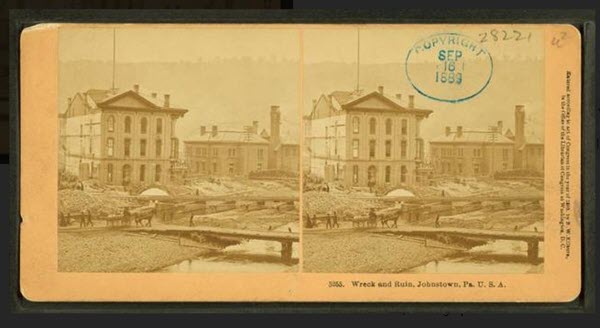
Famous for a flood: “Wreck and Ruin, Johnstown, PA U.S.A.” Kilburn Brothers, Photographer (Public Domain)
What was going on here? The brick wall I was hoping to scale was turning into genealogical quicksand!”
WWLLD Leads to 4 Actionable Steps
“So, in the spirit of WWLLD (“What Would Lisa Louise Do?”), I countered that confusion with the following actions!!
1. Created a private family tree on Ancestry for Caroline (Editor’s note: an idea discussed in episode #229) and her descendants and conducted records searches, which provided clues:
-
-
Two of Caroline’s children were listed as being born in “Hungary” which is something I’ve often seen in my early research (for years, I thought I was Hungarian!)
-
Another child was born in Johnstown in 1888. Besides the Johnstown connection, this was significant since my great-grandparents briefly lived in Johnstown during that same time period before returning to Slovakia.
-
The obituary of another child mentioned that she was buried in a Greek Catholic cemetery in Syracuse. This was also significant since, at that time, Rusyns were usually members of the Byzantine (Greek Catholic) church.
-
2. Used triangulation to validate that all of these “Caroline” matches belonged to my paternal grandfather’s family.
3. Reached out to the DNA matches (heard from just one person who had no information about Caroline).
4. Also used Ancestry’s “Predicted relationship” tool, which showed that these matches and I shared the same gr-gr-great grandparents.
All signs pointed to Caroline being the sister of my paternal great-grandfather, Andreas. But the records for my great-grandfather’s siblings listed Maria, Anna, Anna, Anna, Anna, Elizabeta, George, and Adam. (Yes, there were four different Anna’s among those siblings!). No Caroline to be found there.
I took a closer look at those records though and found that Elizabeta was born the same year as “Caroline” (1859) and later married Joannes Fecko (which sounds somewhat like John Frisco). This is where my intuition kicked in and said I’d found them!
Still, I wanted to be sure, and consulted with a cousin who’s an expert on our Rusyn ancestors. Having traveled back and forth to our ancestral home village, Olsavica, Slovakia many times, cousin Dave has collected lots of records throughout the years. (Most of these records are unavailable online).
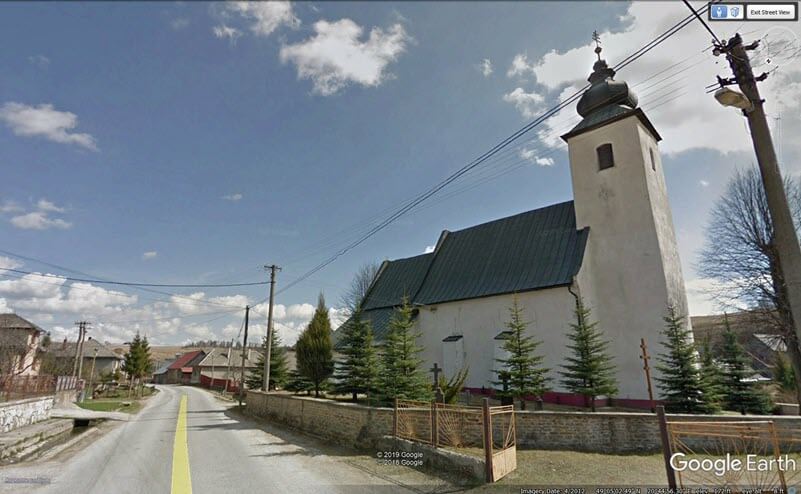
Using Google Earth for Genealogy – Street View of Olsavica today.
Dave reviewed these records against my research and found the marriage for Elizabeta and Joannes. He further found the birth records for two children who were born in Olsavica. The names and birthdates of these children exactly matched the records for the children I’d located.
He concluded that Elizabeta and Joannes immigrated to America in the late 1880s and would have been among the first immigrants from Olsavica to venture to the USA.
He further theorized that, after my great-grandparents returned to Olsavica, Elizabeta and Joannes may have decided to adapt to America ways quicker than they would have otherwise to survive, thus adopting names that (to them) sounded more American.
So, Elizabeta became Caroline and similarly, her husband, Joannes Fecko, became John Frisco! Also, since Elizabeta and Joannes were living in Johnstown during the great flood of 1889, that might have inspired them to relocate to Syracuse.
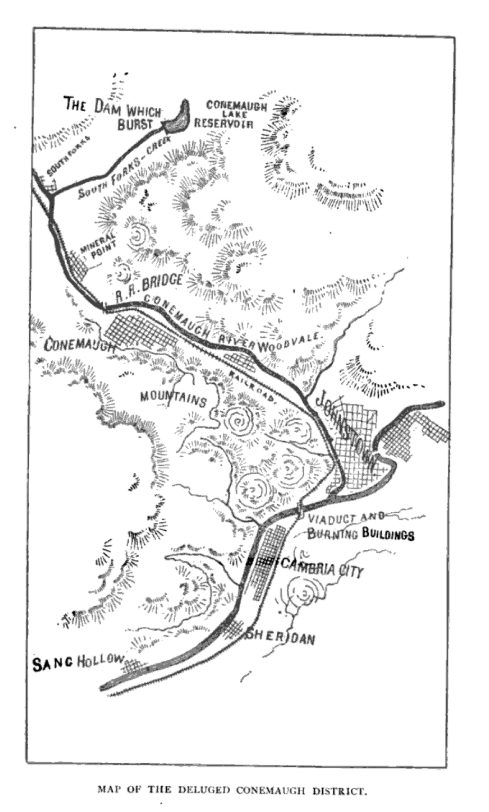
Map of the Johnstown Flood Area. The Premium Video Reconstruct Your Family’s Amazing Stories features genealogical research in this area at that time.
I can only say WHEW!
This is the first time I’ve run into this type of name switching in my ancestral research!
In tandem, I wonder if any living Frisco cousins grew up thinking they had Italian ancestry –and are puzzled as to why this isn’t showing up in their Ancestry DNA results!
Should I ever establish/reestablish contact with any of them, I’m sure they’ll be surprised as well!
I didn’t realize how much knowledge I’d absorbed (actively or even passively) from listening to your podcasts, watching your videos, and reading your articles. But whenever I hit a roadblock, I always had another tool I could pull out, e.g., Hit a dead-end with records? No problem, just study the DNA matches (editor’s note: as we discuss in many Premium videos and podcast episodes like Episode #197.) When that stops working, look at newspapers and Google Books! I had it covered!
(Editor’s note: Here’s a listing of all our articles on Newspaper research. Genealogy Gems Premium eLearning members can watch the full length video class Google Books: The Tool You Should Use Every Day here.)
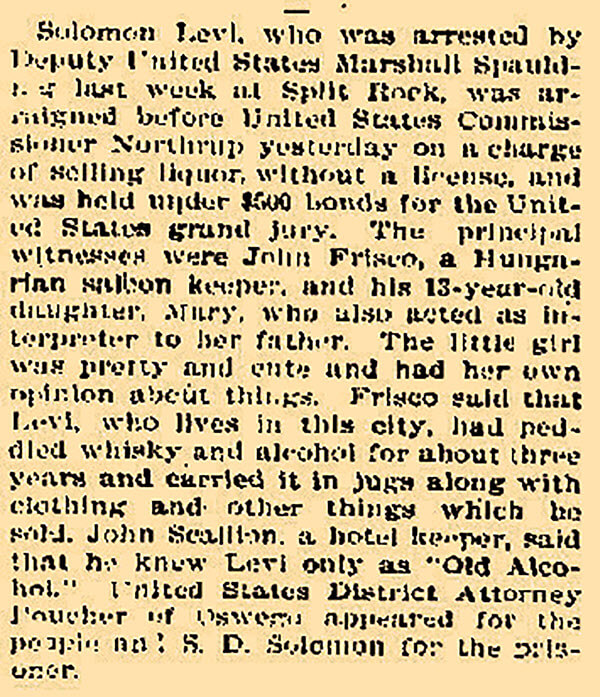
Newspaper found! “Solomon Levi, who was arrested by Deputy United States Marshall Spaulding last week at Split Rock, was arraigned before United States Commissioner Northrup yesterday on a charge of selling liquor without a license, and was held under $500 bonds for the United States grand jury. The principal witnesses were John Frisco, a Hungarian saloon keeper, and his 13-year-old daughter, Mary, who also acted as interpreter to her father. The little girl was pretty and cute and her had own opinion about things. Frisco said that Levi, who lives in this city, had peddled whiskey and alcohol for about three years and carried it in jugs along with clothing and other things which he sold. John Scallion, a hotel keeper, said that he knew Levi as “Old Alcohol,” United States District Attorney (illegible) of Oswego appeared for the people as: S.D. Solon for the (illegible).” January 16, 1896. The Syracuse Standard.
Although I didn’t get this written until (now), rest assured that I thought of each of you at Genealogy Gems and was so grateful!
Thank you for helping me place my Great-Aunt, Elizabeta/Caroline and her descendants in their rightful place in our family tree!! It’s quite a story and I couldn’t have cracked that wall without you.
Thanks for the continual inspiration. I swear my IQ has gone up several points since I began listening to GG!
With gratitude, Natalie Zett”
Share Your Story
Reading the challenges faced and strategies used by other researchers can help to reinvigorate our own genealogical search. Thank you to Natalie for taking the time to write and for providing permission to share her story.
Have you made an exciting discovery thanks to something you heard on the Genealogy Gems Podcast? Please leave a comment below!
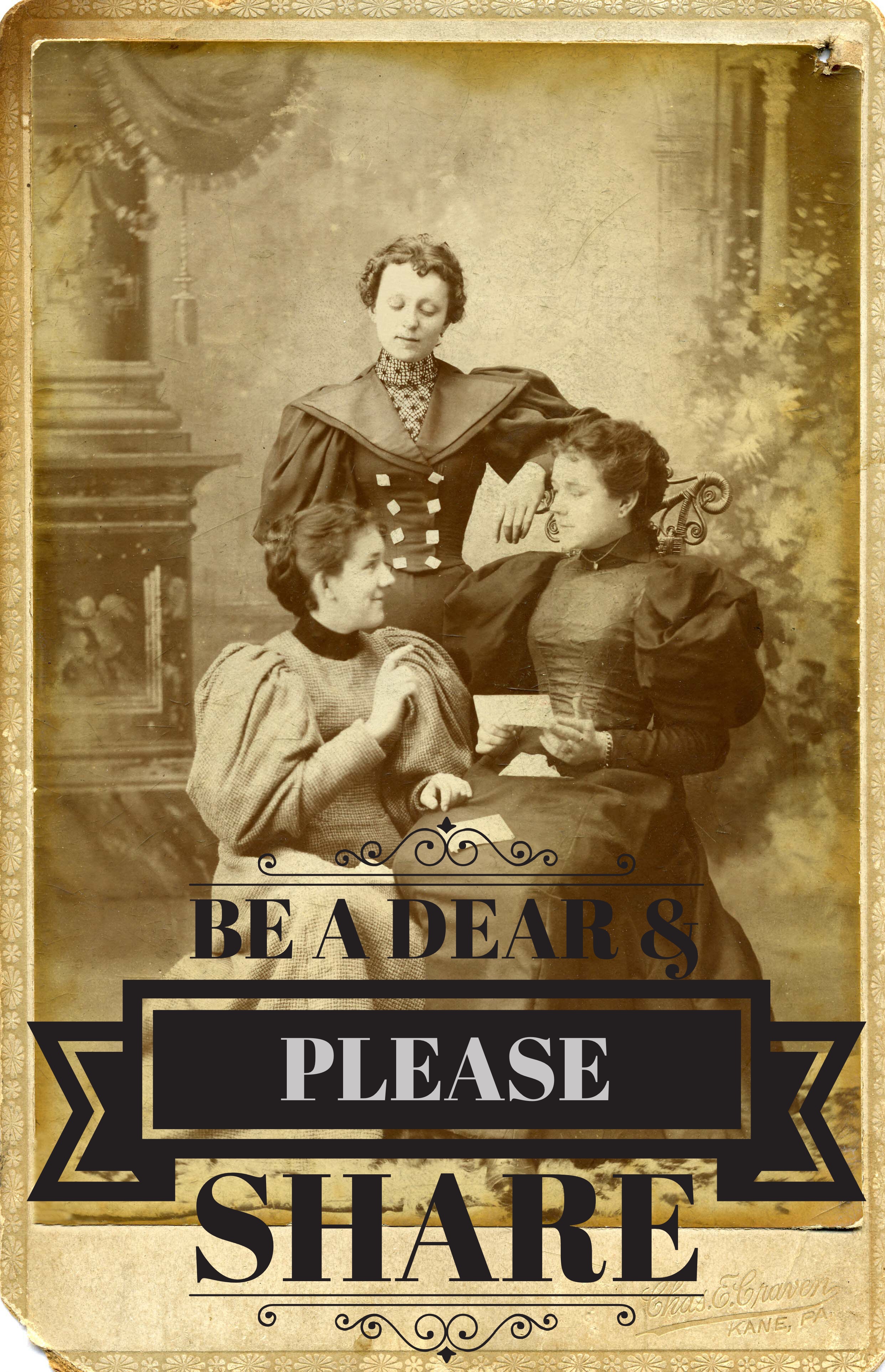
Family History Episode 36 – Your Genealogy Questions Answered, Part 1
Family History: Genealogy Made Easy Podcast
with Lisa Louise Cooke
Republished June 18, 2014

Listen to the Family History: Genealogy Made Easy podcast by Lisa Louise Cooke. It’s a great series for learning the research ropes and well as refreshing your skills.
Download the Show Notes for this Episode
Welcome to this step-by-step series for beginning genealogists—and more experienced ones who want to brush up or learn something new. I first ran this series in 2008-09. So many people have asked about it, I’m bringing it back in weekly segments.
Episode 36: Your Genealogy Questions Answered, Part 1
Today’s show is all about YOU! This episode is made up completely of your emailed questions, comments and stories. I couldn’t do this podcast without you, and I definitely want it to be a two way conversation. Joining me on today’s episode to read your emails is my daughter, Lacey Cooke.
Question: When do I use the GPS (genealogical proof standard) method? How do I know whether what I’ve found meets the genealogy research standard? Do I need a research report for every ancestor? When do I use the research worksheet? – Jenna in Kansas City
Answer: First, put priority on your direct ancestors. I write up research reports on each direct ancestor, but only after I’ve done the bulk of the research on them. Use the research worksheet when you have conflicting or unclear information that needs to be worked over a little more thoroughly. Learn more about navigating your research with the genealogical proof standard in the Family History Made Easy Podcast, Episode 20 and Episode 23.
Question: I need help finding a newspaper article on the killing of my great-great grandfather Thomas Leonard Frazier that originally appeared in The Deseret News in Salt Lake City, Utah. I didn’t cite the source when I first found it! – Kent Frazier
Answer: I found the article you’re looking for at GenealogyBank.com. Online newspapers are scattered all over the internet. I started at GenealogyBank because they have a lot and I have a subscription. If you have trouble finding newspaper article, review the episodes below. You may also want to try regional and state archives, public libraries, genealogical and historical societies and large genealogy or university libraries.
Comment: I just listened to Family History Podcast Episode 33 about hard buy medicine online gurgaon drive file organization, including organizing photos files, and I just listened to Genealogy Gems Podcast Episode 18 (not currently available online) on how to identify old photos by the cars that appear in them. My sister recently sent me a batch of old family photos, including one with the van in which I learned to drive. I decided to organize them according to your suggestions and it’s worked really well. I have one more suggestion: add a caption to each photo’s metadata. It’s like writing about the photo on the back of it.
To add a caption in Windows, right-click on the file, then click Properties. On a Mac, click on the File icon and then in the Finder menu, click on Get Info. I’m using Windows Vista, so this comes up with a window that has three tabs on it: General, Security and Details. Go to the Details tab and click to the right of the fields that are listed there to enable editing. On my computer, there are fields for Title, Subject, Tags and Comments as well as Authors, Date Taken and Date Acquired. There are a number of other fields that can be edited on this screen that have to do with the photographic equipment that was used, so scanned photos from your grandparents’ Kodak Brownie cameras can be updated too. The fields that I fill in are Subject, Tags and where known, the Authors and Date Taken. The Tags field can be very useful for the computer’s search function. If these fields are not available from the operating system itself, most modern photo editing software has functionality that will let you edit these same fields from within the photo software [for example, in Adobe Photoshop, this is under File -> File Info]. –Sean Lamb
In Genealogy Gems Premium Podcast Episode 25, I interviewed Ken Watson who talked about tagging photos with actual GPS (global positioning) coordinates in meta-tags.
Comment: You have inspired me to start a blog! Thanks for Genealogy Gems Podcast Episode 33. –Russ Worthington
Russ provides this link to his blog post about applying my hard drive organization strategies and incorporating Family Tree Maker software. For hard drive organization, see Family History Podcast Episode 32 and Episode 33.
Question: I’ve been doing genealogy for a couple of years on and off. I found your two podcasts and I’m almost caught up on Family History Made Easy. (Next will be the “Genealogy Gems” podcast!) Is there a “best practice” for which name should be used for a woman’s record? Maiden or married? Also, will you recap what a primary source is? –Bob Callahan
Answer: When I started the podcast, I wondered whether having two podcasts was overkill. I’m getting great feedback telling me that’s not the case! A primary source contains genealogical data collected at the time of the event reported by someone of authority and/or who was at the event and has first-hand knowledge. You may have several primary sources for each fact, like a family Bible and a government or church record for a birth or death. (A secondary source for that might be a birth announcement in a newspaper. The reporter obviously wasn’t there and doesn’t have firsthand knowledge of the event. If that’s all you have, dig a little deeper.)
As for your question about women’s names, a woman is listed in on a family tree with the name she was born with: her maiden name. She will be connected to any spouses later in life, and you can get her married name from there. They may appear in records with any of their surnames. A death record on Ancestry.com may have her listed by her married name, but in your family tree you should have her by her maiden name.
Comment: Let me first say that I am a new listener and have been on a Genealogy Gems and Family History Made Easy Podcast marathon! For the past month, I have listened to almost all of your podcasts and have gleaned quite a bit of information…to the point that it has almost overloaded my brain. But that is a good thing because I have a lot of new ideas for expanding the tree that my grandmother started forty plus years ago…
I just listened /watched the Premium Members Video for organizing your hard drive (available only to Premium Members). I have one more suggestion. It’s on how to copy multiple folders with the same name into your surname folders.
When setting up the surname folders and the sub-folders that go inside each, you set up one set of folders inside of one of the surname folders that are brand new with no documents inside of them. Then highlight each of them by first clicking on the first folder inside the surname folder, press and hold the shift key and click on the last folder and then right click on one of the highlighted folders and click copy from the drop down list. Then click and open the next surname folder, right click inside the folder and then click on paste from the drop down folder. –Eric Gomes
This is a GREAT suggestion! I constantly move multiple files at a time, but completely forgot that this can be done with file folders.
Question: Do you have any suggestions on what to look at when checking out and deciding on a society to join? –Eric Gomes
Answer: It depends on what your goals are. If your goals are camaraderie, education, involvement and community service, involve yourself with a local society. Go visit! See how welcoming they are, what kinds of programs they offer and whether they meet your needs. Don’t be shy about meeting the president and asking for a recent copy of their newsletter. Test drive it to see what’s a good fit for you.
If you’re trying to learn about where your ancestor lived, look for a society closest to that area. Look for societies near and far at the Federation of Genealogical Societies website on the Find a Society page. Or Google the name of the city and/or county/province and the keywords “genealogy society” to find what you’re looking for. Coming up dry? Contact a reference or local history/genealogy librarian at a local library or someone at a local historical society to ask for a recommendation.
